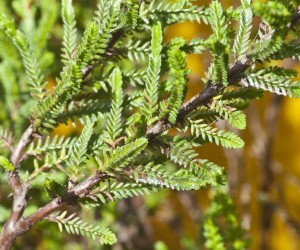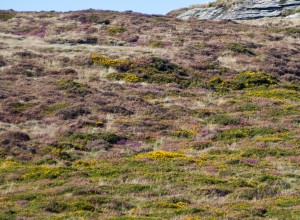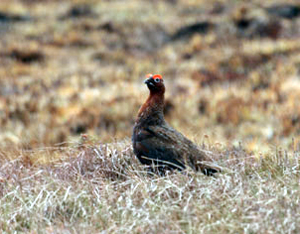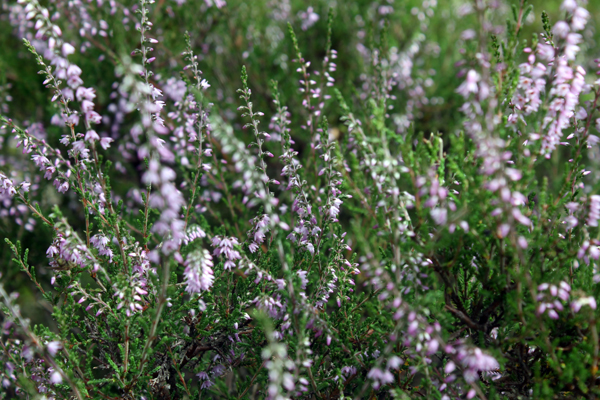Heather and heath.

There are a number of shrubs that have branched woody stems, which can grow to about one metre in height; and are associated with heaths and bogs. There is heather, bilberry, cowberry, crowberry and bearberry. However, the actual height of these plants is dependent on
- their level of exposure to the elements (elevation and aspect) - particularly wind,
- the nature of the soil (its pH, nutrient and water status) and
- the level of grazing by herbivores (deer, sheep, rabbits).
Heather (Calluna vulgaris) or Ling (as it is also referred to) is particularly common on heaths. It may be found in association with Juniper, Western Gorse or Dwarf Gorse. Heather has small, evergreen, 'three-sided' leaves that grow in opposite pairs along the stems. On young shoots, the leaves may form four vertical rows that overlap considerably.
On young shoots, the leaves may form four vertical rows that overlap considerably.
The flowers are pale pink to purple when they form; they are quite small and are much visited by bees. The flowers are borne at the tips of the shoots - in mid to late summer. Ling can be distinguished from Bell Heather as its leaves and flowers are smaller. Ling can grow in dry or wet soils - with an acidic nature; and on peat.
It is to be found in various woodlands - e.g. Caledonian Forest and forms the dominant vegetation on heathlands / heaths. The dry heaths, found within 100km of London are dominated by common heather (with small amounts of bell heather) - with bracken as another common component. The acid, sandy soils of the Breckland have a similar preponderance of heather (together with bracken and sheep's fescue). The wet heaths of Western Scotland are also characterised by Heather; it is the dominant vegetation up to 900M, though above the tree line it is only some 10 - 15 cm in height, and often less. There may be a rich bryophyte flora associated with this heather. Eventually, heather is replaced by bilberry, crowberry, Carex sp and Fescues.
it is the dominant vegetation up to 900M, though above the tree line it is only some 10 - 15 cm in height, and often less. There may be a rich bryophyte flora associated with this heather. Eventually, heather is replaced by bilberry, crowberry, Carex sp and Fescues.
Heather is edible / palatable to sheep, deer and rabbits, so examination of the state of the heather in a given area / habitat can be a useful indicator of grazing intensity. Left ungrazed, the plant can grow to a height of a metre with straight, upright shoots and abundant flowers. Plants that are grazed have their form altered and those subject to environmental stresses are shorter and have fewer flowers. If grazing is really heavy then a grass-dominated vegetation may result, with occasional heather plants - that are lank and woody.
 If moorland is subject to periodic or cyclical burning then a patchwork of differently aged stands of heather may develop. Burning is a management technique where moors are used for grouse / grouse shottinhg. The regenerating heather has young shoots that are tender, palatable and richer in nutrients. High altitudes and exposure to strong winds can result in a compact, almost prostrate form of heather. Heather is also a valuable food resource for many invertebrate species (e.g. the heather beetle) - particularly lepidoptera (butterflies and moths) such as the small emperor moth.
If moorland is subject to periodic or cyclical burning then a patchwork of differently aged stands of heather may develop. Burning is a management technique where moors are used for grouse / grouse shottinhg. The regenerating heather has young shoots that are tender, palatable and richer in nutrients. High altitudes and exposure to strong winds can result in a compact, almost prostrate form of heather. Heather is also a valuable food resource for many invertebrate species (e.g. the heather beetle) - particularly lepidoptera (butterflies and moths) such as the small emperor moth.
Comments are closed for this post.

